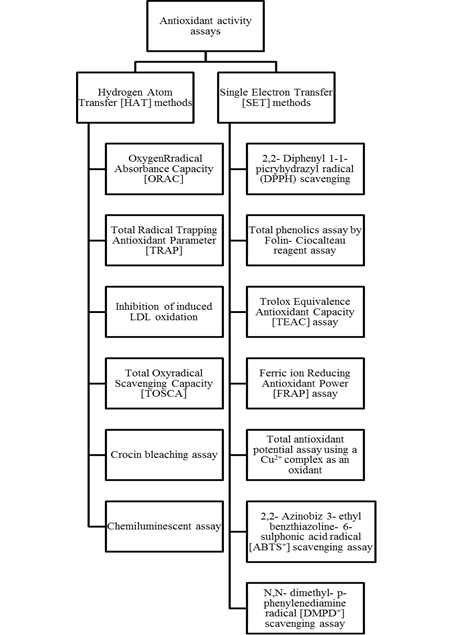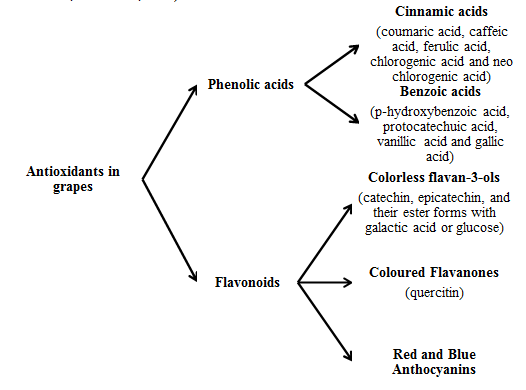Antioxidant potential of Fruits and Vegetables
Kamlesh Prasad1*, Ravneet Kaur1 and Shubhra Shekhar2
1Department of Food Engineering and Technology, SLIET, Longowal, Punjab, India
2Department of Food Process Engineering, NIT, Raurkela, India
- *Corresponding Author:
- Kamlesh Prasad
Department of Food Engineering and Technology, SLIET, Longowal, Punjab, India
Tel: 9417741225
E-mail: profprasad@gmail.com
Received: 19-Aug-2022, Manuscript No. IPJCND-22- 11111; Editor assigned: 22-Aug-2022, PreQC No. IPJCND-22- 11111 (PQ); Reviewed: 05-Sep-2022, QC No IPJCND-22-11111; Revised: 12-Sep-2022, Manuscript No. IPJCND-22-11111(R); Published: 19-Sep-2022
Citation: Prasad K, Kaur R, Shekhar S (2021) Antioxidant Potential of Fruits and Vegetables. J Clin Nutr Diet Vol.7 No.12
Abstract
An antioxidant is of great interest among researchers, scientists, nutritionists, and the public because of its ability to prevent oxidative damage, as indicated by various studies. This chapter mainly focuses on the free radicals and their types; antioxidants and their mode of action against free radicals; fruits, vegetables, and their byproducts as a source of antioxidants; and various analytical methods employed for assessing antioxidant activity. Antioxidants discussed in this chapter are ascorbic acid, vitamin E, carotenoids and polyphenols, and their mechanism of action. Different antioxidant activity assay techniques have been reported. Fruits and vegetables are abundant sources of these secondary metabolites. The waste generated during processing has many bioactive materials, which possibly be used in value-added by-products.
Keywords
Antioxidant;Freeradical;Oxidativestress;Secondarymetabolite;Ascorbicacid;Carotenoids; Polyphenol; Degenerative diseases
Introduction
The word antioxidant is commonly heard nowadays, especially whenever there comes a topic of health concern. People consume antioxidants as a symbol of a healthy lifestyle to fight against various health problems, better skin, and anti-aging benefits. What makes antioxidants so important? The trait responsible for such importance of antioxidants is their ability to stop free radical reactions that can have potentially deleterious effects [142]. This gives rise to various questions like- What are the free radicals? What are the sources of free radicals? What are their harmful effects? What are antioxidants? What are the common sources of antioxidants? How do they work against free radicals? Answers to these questions are discussed in the present chapter.
Free radicals
Free radicals are those atoms or molecules with an unpaired electron in their outer orbit [42]. Any electron present alone in an orbital is referred to as an unpaired electron, and it is accountable for the reactive and unstable state of the free radical. The vital class of free radicals generated in a living system is usually derived from Oxygen and Reactive Oxygen Species (ROS) [3]. Hydroperoxyl (HO2O), alkoxy (ROO), peroxyl (RO2O), hydroxyl (OHO), and superoxide radical (HO2O) are common among Oxygen free radicals. Nitrosative stress is the condition that occurs due to the overproduction of Reactive Nitrogen Species (RNS) [67,121]. Nitric oxide (NOO) and nitrogen dioxide (NO2O), the nitrogen-free radicals can also be converted into other nonreactive species under the antioxidant-dependent reactions. Thus, ROS and RNS include radicals and non-radical species like hydrogen peroxide, singlet oxygen, ozone, organic peroxide, peroxynitrite, nitrosyl cation, nitroxyl cation, dinitrogen trioxide, and nitrous acid [35]. When Reactive Oxygen Species (ROS) reacts with thiols, they give rise to Reactive Sulfur Species (RSS) [84].
The most reactive hydroxyl free radical is formed by exposure to ionizing radiations. These radiations lead to the formation of Ho and OHO by causing the fission of OH bonds in water

Harmful effects are initiated when the hydroxyl radical reacts with macronutrients such as carbohydrates, protein, and lipids along with DNA, the genetic material [147].
Molecular Oxygen receives one electron and is converted to superoxide anion, a reduced form [52]. Superoxide anion is formed in the mitochondria during the initial step of the electron transport system [37]. Oxygen is reduced to water during the electron chain reaction. The electrons escape a chain reaction and react directly with Oxygen in its formation [52].

Many other reactive oxygen species are also formed in the living system by the formed superoxide anions. These include hydrogen peroxide, hydroxyl radicals or singlet oxygen [139].
Hydrogen peroxide (H2O2) is a nonradical that is formed by the superoxide radical when it undergoes nonenzymatic or enzyme-catalyzed (Superoxide Dismutase, SOD) dismutation reaction. It is very diffusible within and between the cells [21].

In the presence of metal ions and superoxide anion, hydrogen peroxide generates a hydroxyl radical.

Nitric oxide is formed during the metabolization of arginine to citrulline by the enzyme Nitric Oxide Synthase (NOSs) via five electron oxidative reactions [40]. Nitric oxide readily diffuses through cytoplasm and plasma membranes due to its solubility in both liquid and liquid media [23].

Sources of Free Radicals and Harmful Effects
Oxygen, an essential element of life, also has harmful effects on the human body by forming reactive oxygen species [83]. Free radicals are produced internally as well as due to external factors.
Internal factors
- Normal metabolism within mitochondria during electron transport reactions and another mechanism [17]
- Xanthine oxides
- Inflammation Processes by neutrophils and macrophages
- Phagocytosis
- Ischaemia
- Peroxisomes [83]
External factors
- Radiation
- UV rays, X rays, γ rays
- Environmental pollutants
- Certain drugs, pesticides, anesthetics
- Ozone
- Cigarette smoke [74]
Reactive oxygen species mediate damage to cells structures, including lipids and membrane protein and the nucleic acid under the presence of its higher concentration. This condition is termed oxidative stress [112]. These free radicals’ processes are also associated with various food products. The rancidity of fatty foods like potato chips and butter is due to free radical chain oxidation. Oxidation of Polyunsaturated Fatty Acid (PUFA) is also associated with free-radical processes [114]. The importance of antioxidants is because of their property to stop the free radical chain reaction.
Antioxidants
An antioxidant is a chemical compound that has free radical scavenging properties, can delay or inhibit cellular damage and neutralize the effect of free radical by donating an electron [48]. Antioxidants thus counteract oxidative stress. A series of defense mechanisms have been developed to combat the exposure to free radicals from various sources [18]. Antioxidants further contribute to disease prevention and protect cells from the toxic effects of free radicals by neutralizing their excess. Antioxidants can be endogenous, generated in situ or exogenous, supplied through food [111].
To prevent the condition like oxidative stress, it is essential to maintain a balance between the production of free radicals and antioxidants defense [5]. Fruits and vegetables are consumed by people as a source of antioxidants, as they are rich in flavonoids and antioxidants. It contributes by protecting the human being from cancer and cardiovascular problems, the ill effects of free radicals [49].
Antioxidants remove free radical intermediates and prevent or slow down the oxidation of other molecules by being oxidized themselves and terminate the chain reactions [133].
Antioxidants can act as
- Scavenging the peroxidation initiating species
- Decomposition of lipid peroxide
- prevent the generation of reactive species by chelating metal ion
- Preventing the formation of peroxides by quenching activity
- Reducing localized O2 concentrations [99]
Antioxidants also play an essential role in food products by preventing oxidation reactions, browning in fruits and vegetables, and rancidity in fats and oil [49].
Antioxidants may be of natural or synthetic origin. Natural antioxidants are the important secondary metabolites of plant origins mainly explored in preparing some functional foods. In food systems, during storage, the use of nutritional antioxidants and the micro-nutrient such as vitamin E helps maintain the color, texture, and flavor of the food product by preventing or retarding lipid peroxidation and reducing lipid peroxidation protein oxidation [32].
Vitamin C
Ascorbic acid is a water-soluble vitamin commonly known as Vitamin C and was reckoned as L-ascorbic acid in 1965 by the IUPAC- IUB commission on biochemical nomenclature. Ascorbic acid has a 2,3-enediol group responsible for its antioxidant activity [81]. It is a 6-carbon lactone and cannot be synthesized in the human body, and is water-soluble; it must be regularly supplied through external means.
It plays an essential role in the biosynthesis of collagen, carnitine, and neurotransmitters [81]. The normal metabolic respiration process of the body produces potentially damaging free radicals. These free radicals can be efficiently quenched by ascorbic acid due to its reducing nature [2].
Ascorbic acid, after oxidation, leads to the formation of a dimer called Dehydroascorbic Acid (DHA). DHA is an oxidized form of ascorbic acid and can be reduced back to ascorbic acid by the action of glutathione (GSH) [1]. In aqueous solutions,Dehydroascorbic acid exists as hydrated hemiketal [126].
The formation of dehydroascorbic acid from ascorbic acid is a two-step reversible oxidation process, during which ascorbyl radical is formed as an intermediate [75]. Ascorbyl radical is involved in the termination of free radical reactions, due to the delocalized nature of unpaired electron present in it, it reacts with free radicals [126].
Dehydro-ascorbate is irreversibly converted to 2,3-diketo-L-gluconic acid with the hydrolysis of lactone ring [12,22]. Diketo-L-gluconic acid is unstable and does not have biological activity [26].
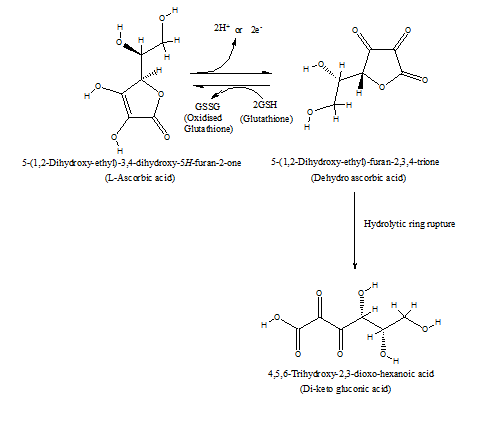
In fruits and vegetables with low levels of antioxidant (Vitamin C), on cutting, there is the exposure of the phenolic group to Oxygen, and the cresolase and catecholase activity act and form quinone, which converts further to dopachrome before its polymerization into brown melanin pigment. Ascorbic acid can reverse this reaction, which converts quinones back to phenolic form [82].

Termination of lipid peroxidation chain reaction is carried by ascorbic acid by donating an electron to lipid radical, which gets converted to ascorbate radical. These ascorbate radicals further react with each other to form ascorbate and dehydroascorbate molecules. Dehydroascorbate molecule on the addition of two electrons is converted back to ascorbate molecule because DHA does not have the antioxidant capacity, and this process is carried out by oxidoreductase [102].
Ascorbic acid prevents the formation of N- nitrosamines in nitrate-cured meats. It results in NO's formation, which is desirable for cured meats color [82]. L- ascorbic acid protects against oxidation of low-density lipoprotein implicated in the development of atherosclerosis by scavenging reactive oxygen species, which prevent oxidative stress [58].
Vitamin E
Vitamin E is a fat-soluble vitamin found in tocopherol and tocotrienol structures which exists in eight different isomeric forms equal configurations for both the forms [34]. All eight forms are lipophilic. Chromanol group is responsible for antioxidant activities, and its methylation differs among all the members of the vitamin E group [101].
Amount of methyl groups attached to phenol ring and pattern of methylation are responsible for reactive antioxidant activities for these isomers, which is found to be α>β>γ>δ. The highest activity of α - tocopherol is due to the presence of 3-methyl substituents [64]. The Food and Nutrition Board defines Vitamin E requirements in the human body are fulfilled only by α- tocopherol.
Vitamin E repairs the oxidizing radicals during lipid auto-oxidation and halts the propagation step, thus acting as a chain-breaking antioxidant [127].

Ascorbic acid is responsible for the regeneration of α - tocopherol from α - tocopherol radical. Thus, there is a synergistic effect between α-tocopherol and ascorbic acid [150].
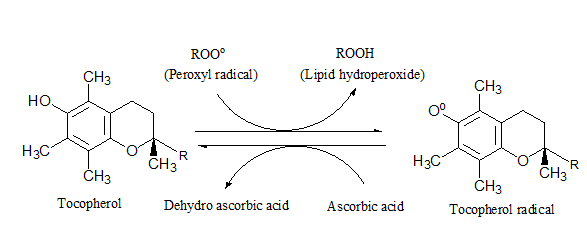
Vitamin E consumption plays an essential role in preventing the oxidation of low-density lipoprotein cholesterol and reduces the risk of heart diseases [54]. Otherwise, it may lead to atherosclerosis. Vitamin E intake is associated with preventing several diseases like cancer, cardiovascular diseases, eye disorders, neurological disorders, and aging [5].
Carotenoids
Carotenoidsareyellow-redpigmentssynthesizednaturallybyplantsandsomemicroorganisms [108]. They have an isoprenoid polyene structure [16]. These are a group of tetra terpenoids that they contain eight isoprene units with 40 carbon atoms.
Carotenoids can be categorized into two groups
- Carotenoid hydrocarbons (carotenes) contains specific end group as in β-carotene or lycopene
- Oxygen carotenoids (xanthophylls) as zeaxanthin and lutein [108]
Consumption of foods that are a rich source of carotenoids is related to a decrease in age-related diseases. Coronary heart diseases associated with oxidation of LDL cholesterol can be prevented by lycopene and β carotene [149].
Antioxidant activities of carotenoids are due to their structure which contains conjugated double bond, and their ability to delocalize unpaired electrons [96]. Singlet molecular oxygen 1O2 and peroxyl radicals are among the two reactive oxygen species that are most likely to be scavenged by carotenoids [151]. At a low concentration of Oxygen, the antioxidant activity of carotenoids increases, and at higher concentrations, it acts as a pro-oxidant [29].
Scavenging of superoxide anions (•O2-) by β- carotene occurs as follows [30].

Carotenoids can hinder free radical chain reactions that occur during lipid peroxidation due to their antioxidant activity. Free radical reactions proceed in the following manner [69].
Initiation

Propagation

Termination

This chain reaction can be inhibited by carotenoids in 3 ways [68].

- Hydrogen abstraction

- Addition of radical species

The photooxidative process leads to eye and skin diseases on exposure to light. The light filtering effect and antioxidant activity of carotenoids can protect against the ill effects of these processes [138]. β carotene acts as a provitamin and precursor for the formation of vitamin A in the human body.
Polyphenols
Polyphenols are chemical compounds having phenolic structures and are obtained from plant sources [144]. These have several bioactive properties like they may act as attracting agents for pollinators, contribute to pigmentation of plants, as an antioxidant, and protection from UV light [98].
The chemical structure of these compounds comprises an aromatic ring with one or more hydroxyl groups. These can be simple phenolics or in polymeric form having high molecular mass [6]. The most important group of polyphenols is flavonoids (glycosides with benzopyrone nucleus). Flavonoids include flavones, flavonols, flavanone, flavonols, and anthocyanins [135]. Flavonoids consist of 15 carbon atoms having an arrangement as shown below in fig. These are compounds having a low molecular weight [90].
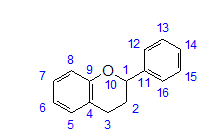
Flavonoids
The antioxidant activity of these compounds is due to their ability to donate hydrogen and metal ion chelation [15]. Phenolic radicals formed after presenting hydrogen atoms do not readily participate in other radical reactions, as they become resonance stabilized [79]. Flavonoids can form a complex with metals and thus prevents metal-initiated lipid oxidation [55].
The difference in structure and glycosylation patterns of these compounds is responsible for their different antioxidant activity. Glycosides of anthocyanidins are called anthocyanins. These are the most extensive water-soluble pigments, commonly present in flowers and fruits [15].
Tannins are an important group of polyphenolic compounds, having high molecular weight. These are categorized as hydrolyzable and condensed tannins [113]. Hydrolyzable tannins are derived from the esterification of gallic acid (3,4,5-trihydroxy benzoic acid). Galloyl group of core polyol (formed from esterification of gallic acid) is further esterified to obtain hydrolyzable tannins [46]. Condensed tannins are the polymeric compounds obtained from polyhydroxy flavan-3-ol. These are also known as pro-anthocyanidins [113]. Tannins have metal ion chelating properties, act as an agent for protein precipitation, and possess antioxidant activity [46].
Polyphenolic compounds act as antioxidants to inactivate free radicals by two mechanisms

- Hydrogen atom transfer mechanism
- Single electron transfer mechanism
It is supposed that an antioxidant ArOH transfers its hydrogen atom to react with free radical in the hydrogen atom transfer mechanism.
In the single electron transfer mechanism, it is supposed that an oxidant donates an electron to the antioxidant molecule [80]

Methods for Antioxidant Assessment
Antioxidants play an essential role in problems related to oxidative stress, such as neurodegenerative and cardiovascular diseases. People nowadays are more focused on antioxidant-rich foods, so it is vital to assess these components' antioxidant activity or free radical scavenging capacity. There are various ways of measuring antioxidant activity (Figure 1). Different methods follow different reaction mechanisms. These can be classified according to the reaction mechanism as:
Hydrogen Atom Transfer (HAT) method is based on the determination of free radical scavenging activity of antioxidants by donating a hydrogen atom. These are rapid reactions and do not depend on pH and solvent but are affected by the existence of reducing agents [117]. In contrast, the Single Electron Transfer (SET) method is based on the ability of an antioxidant component to reduce the compounds such as carbonyls, radicals or metal ions by transferring a single electron [57]. The most commonly used method is the Oxygen Radical Absorbance Capacity (ORAC) assay. This method is based on the principle of decrease in intensity of fluorescent compounds like β- phycoerythrin or fluorescein due to the oxidative degradation by radicals (which leads to the formation of non- fluorescent compound) generated from thermal decomposition of AAPH (2, 2'- azobis (2- amidino propane) dihydrochloride) which is used as free radical generator. The antioxidant activity is measured as a decrease in the amount and rate of formation of non-fluorescent products [19,107]. This method provides an advantage that by altering the solvent and source of free radicals, it is possible to determine the hydrophilic and hydrophobic antioxidants. In this method, a controlled source of radicals is provided that simulates the reactions between lipids and antioxidants in food [106,116].
The Total Radical-trapping Antioxidant Parameter (TRAP) assay is based on the same principle as ORAC. The antioxidant activity is measured as the moles of peroxyl radicals that are trapped by one liter of antioxidant solution. Like the ORAC method, the loss of fluorescence is monitored. Trolox is used as a standard to compare the plasma-induced lag phase to that induced by antioxidant sample solution in the same plasma sample. It determines the activity of non-enzymatic antioxidants like ascorbic acid and glutathione, but this method is time-consuming and requires expertise [57].
Ferric Reducing Antioxidant Power (FRAP) assay is based on the formation of the blue-colored ferrous complex by the antioxidants by reducing ferric 2,4,6- tripyridyl- s-triazine complex [Fe3+-(TPTZ)2]3+ in an acidic medium [8]. Reactions carried out under acidic conditions (pH 3.6) to maintain the solubility of iron. Reducing 1M ferric ions to ferrous ions is known as one FRAP unit [85].
In the method of DPPH (2,2- Diphenyl- 1- picryl hydrazyl) assay, the ability of an antioxidant to scavenge DPPH radical (purple color) and reduce it to diphenyl picryl hydrazine (yellow color) is measured. Reaction carried out in an alcoholic solution [123]. Generally, the results are described as efficient concentration (EC 50). To bring about a 50% decrease in the concentration of DPPH, the amount of antioxidant required is reported as EC50 value [14].
Sources of Antioxidants
Besides providing essential nutrients, fruits and vegetables also contain substantial amounts of biologically active secondary metabolites [131]. The secondary metabolites of plants that provide numerous health benefits are covered elsewhere [51,134]. The principal dietary components found in the antioxidant properties of fruits and vegetables are polyphenols, flavonoids, carotenoids, vitamin C, vitamin E, glutathione, selenium indoles, and protease inhibitors (Table 1) [65].
| Antioxidant | Chemical structure | Antioxidant activity (mm) |
Sources |
|---|---|---|---|
| Vitamins | |||
| Vitamin C | 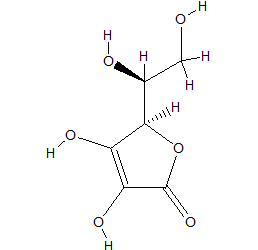 |
1.0 ± 0.02 | Citrus fruits, gooseberry, broccoli, spinach |
| Vitamin E |  |
1.0 ± 0.03 | Green leafy vegetables, nuts |
| Carotenoids | |||
| β- Carotene |  |
1.9 ± 0.1 | Beetroot, apricots, carrots, tomatoes, mango,papaya, oranges |
| α- Carotene |  |
1.3 ± 0.04 | Carrots, leafy vegetables |
| Lycopene |  |
2.9 ± 0.15 | Apricots, grapefruit, guava,watermelon, papaya, carrots, tomato |
| Lutein |  |
1.5 ± 0.1 | Banana, satsuma peel, egg yolk, green vegetables |
| Flavonoids Flavanones | |||
| Naringenin | 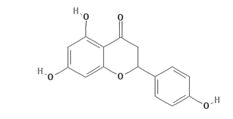 |
1.5 ± 0.05 | Citrus fruits |
| Taxifolin | 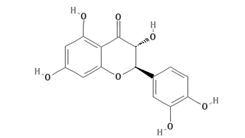 |
1.9 ± 0.03 | Citrus fruits |
| Hesperidin | 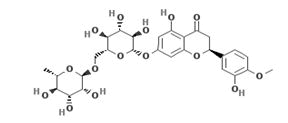 |
1.0 ± 0.03 | Orange |
| Flavones | |||
| Luteolin | 2.1 ± 0.05 | Red pepper, celery, olive | |
| Apigenin | 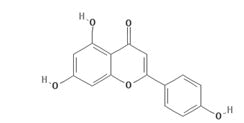 |
1.5 ± 0.08 | Celery, parsley |
| Flavonols | |||
| Quercitin | 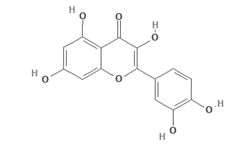 |
4.7 ± 0.10 | Onion, lettuce, broccoli, tomato, tea, red wine,apple |
| Kaempferol | 1.3 ± 0.08 | Leek, broccoli, grapefruit, tea | |
| Flavanals | |||
| Epicatechin | 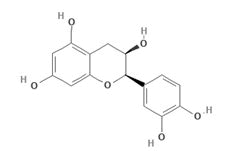 |
2.4 ± 0.02 | Apricot, cherry, grape, peach, blackberry, apple,tea |
| Epigallocatechin | 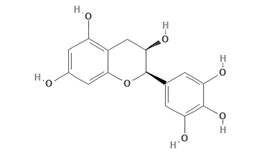 |
3.8 ± 0.06 | tea |
| Epi catechin gallate | 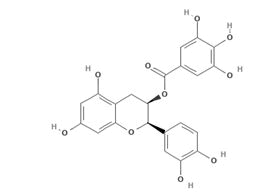 |
4.9 ± 0.02 | tea |
| Anthocyanidins | |||
| Cyanidin | 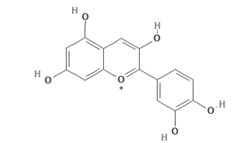 |
4.4 ± 0.12 | Cherry, raspberry, strawberry |
| Delphinidin | 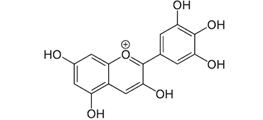 |
4.4 ± 0.11 | Aubergine skin |
| Hydroxycinnamic acid | |||
| Caffeic acid | 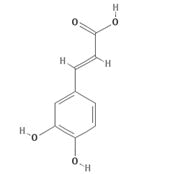 |
1.3 ± 0.01 | White grapes, cabbage, asparagus, olive |
| Ferulic acid | 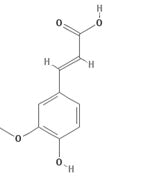 |
1.9 ± 0.02 | Cabbage, tomato, asparagus |
| p- coumaric acid | 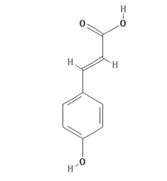 |
2.2 ± 0.06 | White grapes, cabbage, asparagus, tomato |
| Chlorogenic acid | 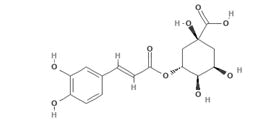 |
1.3 ± 0.02 | Apple, peach, pear, cherry, tomato |
Table 1: Antioxidant, chemical structure, antioxidant activity, and sources.
The varying amounts of waste material are generated during the preparation of cut or processed fruits and vegetables [61]. Peels and seeds are the byproducts generated in large amounts during minimal processing of fruits and vegetables and comprise of large quantities of phytochemical components with antimicrobial and antioxidant properties [97,130,145].All of these can be effectively utilized as a source of antioxidants. The fruits and vegetable tissues are rich in bioactive compounds like phenolics, vitamins, and carotenoids. These are even present in higher amounts in byproducts compared to the final product [4].
Grapes
Fresh grapes, grape juice, and grape wine are excellent sources of phenolic antioxidants (Figure 2). Flavonoids and other phenolic compounds present in grapes have anticarcinogenic, anti-allergic, anti-inflammatory, hepatotoxic, and antioxidative effects [24,92]. The majority of phenolics present in grapes are 60-70% in seeds and 28-35% in the skin, whereas pulp contains utmost to 10%. These phenolics can act as free radical scavengers and act as antioxidants. The grape seed oil also offers various health benefits like improving vision, protection of skin from sun damage, improved blood circulation, reduced oxidation of low-density lipoproteins, and reduced risk of coronary heart disease [129]. The antioxidant activity of grape juice is highest among the commercial juices, followed by grapefruit juice, tomato, orange, and apple [147]. Phenolic antioxidants obtained from grape pomace were found to exhibit the property to retard oxidation of human Low-Density Lipoprotein (LDL) cholesterol [93].
Apple
"An apple a day keeps the doctor away," can be attributed to the number of phytochemicals present in apples. Apple is a rich source of polyphenols, vitamins, and carotenoids that prevent free radical damage due to their high antioxidant activity. Antioxidant compounds in apples are quercitin-3-glucoside, quercitin-3-galactoside, catechin, epicatechin, procyanidin, cyanidin-3-galactoside, chlorogenic acid, coumaric acid, and gallic acid [13]. The amount of these compounds varies with the cultivars and between the flesh and peel of an apple. These phytochemicals are rice in peels as compared to flesh. Peels contain a high amount of quercetin conjugates whereas, chlorogenic acid is present in higher concentrations in the flesh [33]. Phloridzin, an antioxidant compound, mainly present in apple seeds [31], is a derivative of chalcone, also having anti-diabetic activity because of its ability to inhibit sodium-linked glucose transport, thus limiting the absorption of glucose in the intestine and kidney [28,87].
Berries
Berries are highly perishable, soft fruits, including strawberries, raspberries, blueberry, blackberry, blackcurrant, bilberry, and cranberry are rich source of bioactive compounds, mainly phenolics [141]. Blackcurrant, bilberry, and chokeberry contain a higher amount of phenolic content as compared to other berries [62]. Phenolic acids present in berry fruits include p-hydroxybenzoic acid, gallic acid, salicylic acid, ellagic acid (benzoic acid derivatives) and p- coumaric acid ferulic acid, caffeic acid (cinnamic acid derivatives) [47]. Hydrocinnamic acids can inhibit LDL oxidation [91]. There is a decrease in the phenolic content of strawberries during the development from the unripe to the ripened stage [120]. Strawberries have a similar total antioxidant capacity as that of blackberries and raspberries but are lower than blueberries [63].
Other than cut fruits, most of the berries are used as raw material for the preparation of various processed products like jams, jellies, and juices. During the processing, a large amount of waste is generated. This waste can be used to recover highly valuable bioactive compounds. Blackberry and raspberry seeds can be used for extraction of oil that is rich in antioxidant compounds such as phenols, carotenoids, and tocopherols along with linoleic acid (omega -6) and α- linoleic acid (omega-3) in 2 to 4:1 ratio [118]. Leaves and pomace from cranberry juice processing have more antioxidant activity and contain a higher amount of polyphenols than the juice [105].
Pomegranate
Pomegranate (Punica granatum) arils have high antioxidant activity [41] due to phenolic compounds such as anthocyanins (cyanidin, delphinidin, pelargonidin 3-glucoside and 3,5-diglucoside), punicalagin isomers and ellagic acid derivatives. These compounds inhibit lipid oxidation due to their free radical scavenging activity [103].
Pomegranate peels and seeds that are the byproducts of juice processing are wasted or used as animal feed. But, it has been found that the amount of bioactive compounds or the antioxidant activity of the extracts of peel is higher than that of juice [154]. Pomegranate seeds can be used for oil extraction that contains bioactive components. The oil extracted from pomegranate seeds has fatty acid called punicic acid (conjugated linoleic acid isomer) [66] that constitute about 70- 76% of the seed oil and has high phytosterol content [73]. There are various health benefits of this pomegranate seed oil due to its unique chemical composition. Some of these benefits include modifying blood lipid profile in people suffering from hyperlipidemia [60].
Orange
Orange segments are a rich source of carotenoids (a class of natural pigments), such as zeaxanthin, β- cryptoxanthin, antheraxanthin, violaxanthin, and mutatoxanthin. Consumption of carotenoids is linked with reducing the risk of degenerative diseases in the body [104]. Oranges are rich in various antioxidant compounds, mainly ascorbic acid and phenolic compounds [38].
During the processing of oranges for juice manufacturing, a large amount of waste comprises peels and seeds. These are an abundant source of phytochemicals that are associated with a reduction of free radical damages. Various flavonoids have been identified in the orange peel, including hydroxylated poly ethoxy flavones and methylated flavonoids. These bioactive compounds are found to have protective action against oxidative stress [86].
Banana
Banana is a global food that belongs to the genus Musa [76]. Major producers of bananas in the world are India, China, the Philippines, and Ecuador. The largest importer and exporter of bananas globally are the USA and Ecuador, respectively [36]. There is a distinctive arrangement of secondary metabolites in a banana that is responsible for its antioxidant properties. Dessert banana is a rich source of various polyphenolic compounds and flavonols. The major polyphenolic compounds present in the edible part are catechins, epicatechins, gallic acid, tannins and anthocyanins [89]. Bananas are also an abundant source of carotenoids, mainly present in peels. The major carotenoids include lutein, violaxanthin, neoxanthin, isoleucine, α- and β- carotene [140]. Seratonin is a biogenic amine found in banana that imparts the feeling of happiness and wellbeing. The antioxidant potential of banana peels is more potent than that of pulp, inhibits lipid peroxidation, and has high free radical scavenging activity [43].
Banana offers several health benefits, such as retardation of the aging process, reducing the risk of degenerative diseases like heart problems, atherosclerosis, brain dysfunction, and inflammation. It also provides resistance against oxidative changes in low-density lipoprotein and reduces oxidative stress due to bioactive compounds like dopamine and ascorbic acid. Serotonin stimulates the intestinal smooth muscles and thus inhibiting gastric secretion [72]. Banana peel can be utilized as a potential source of antioxidant compounds instead of discarding it.
Mango
Mango comes second, after the banana, regarding production. India is the largest producer of mango. The edible slices of mongo consist of significant amounts of antioxidant compounds. Xanthones are found in high concentrations comprising mainly of mangiferin (1,3,6,7- tetrahydroxyxanthone-2-glycopyranoside) and c-glucoside xanthone [10].
Mango by products, mainly peels, have shown high antioxidant activity. The phenolics and flavonoid content of mango peels is responsible for its anti-proliferative potential against cancer cells [94]. Mangiferin content of peels is about three times higher than that of pulp [124]. Gallo-tannins are found in higher amounts in mango kernels (15.5 mg/gm dry matter) followed by peel (1.4 mg/gm dry matter) and lowest in pulp (0.2 mg/gm) [9]. Mango peel extracts can scavenge singlet oxygen (1O2), hydroxyl radical and superoxide anion due to the presence of compounds- ethyl gallate and Penta-o-galloyl glucoside [59].
Tomato
Tomato is an important and widely consumed vegetable [132]. It is considered beneficial for health as it provides carotenoids, flavonoids, and phenolic acids [137]. During the production of tomato juice, about 3-7% of raw material is wasted, which comprises skin and seed.
Tomatoes are a rich source of carotenoid, the lycopene responsible for their characteristic red color [128]. The lycopene content of tomato peel is five times higher than pulp [88]. Thus, the hot break method is preferred in tomato juice extraction to get the tomato product of intense redness due to higher lycopene concentration.
Carrot
Carrot is a significant and widely consumed root vegetable that is a rich source of dietary fiber andsecondarymetabolites,mainlycarotenoidsandphenolics[50,51,119].Carrotprovidessubstantial health benefits [45] due to compounds like tocopherol, ascorbic acid, and β- carotene and hence is also called vitaminized food [53].
Carotenoids acts as a precursor of vitamin A, especially the β- carotene, which are the major bioactive components present in carrots [100]. The most prevalent phenolic acid present in carrots is caffeic acid and thiamin, folic acid, riboflavin, and vitamin C, which are in considerable amounts of carrot roots [56]. Carrot peel, the by-product of the processing industry, accounts for about 11% of the fresh carrot and can provide 54.1% of the total phenolic content of carrot. Therefore, these peels can be utilized for the value addition of various food products [153].
Garlic
Garlic is widely consumed as a spice and flavoring agent. Because of its preventive and curative action against various ailments, it is widely utilized for dietary and medicinal values [115,122]. Garlic consists of the high content of γ- glutamylcysteine, which is believed to be responsible for various health benefits provided by garlic, along with other sulfur-containing compounds [7]. The chief bioactive component of garlic is allicin (diallyl this sulphonate). Raw garlic homogenate also consists of other significant sulfur-containing compounds, including allyl methyl sulphonate, γ- glutamyl cysteine, and 1- propenyl allyl thio sulphonate [78].
Garlic has been found to increase the resistance against LDL oxidation and thus is beneficial for heart and blood vessels because oxidative modification of LDL can lead to the formation of plaque in blood vessels by deposition of fatty streaks [77]. Garlic in the form of 10% homogenate in a salt solution and its supernatant fraction was found to be capable of reducing the free radicals generated from the Fenton reaction, and it was also effective in reducing the free radicals in cigarette smoke [143].
Garlic shows protective action against oxidative damage of tissues induced by nicotine. It was also found to be effective against carbon tetrachloride damage. Rats intoxicated with carbon tetrachloride were given an oral dosage of garlic oil, and it was found to prevent liver damage by peroxidation of lipids, alkaline phosphatase, and serum transaminase. These results are similar to that of vitamin E [3].
Onion
Onion consists of substantial bioactive compounds, mainly flavonoids [125]. Flavonols are the significant flavonoids present in onions, quercetin derivatives being the most important ones [136]. Quercitin 3,4'-diglucoside and quercitin 4'- glucoside accounts for around 80-95% of total flavonols [44].
Some varieties of red onions also consist of anthocyanins. Anthocyanins are mainly concentrated in the outer skin of the onion (63%), and flavonoids in the skin are present mainly in aglycone forms [39]. So, the onion skin, which is generated as a waste, can be used to extract bioactive components.
Potato
Potato is considered the king of vegetables. It is the most widely consumed vegetable and the significant raw material for processed products like chips, fingers, fries, etc., during the processing of potatoes; peels are a considerable waste. Potato waste consists of various antioxidant compounds: caffeic acid, chlorogenic acid, protocatechuic acid, gallic acid, and para-hydroxybenzoic acid [95]. The antioxidant capacity of polyphenolic extracts obtained from potato peels is found to be analogous to that of synthetic antioxidants [BHA (Butylated Hydroxy Anisole) and BHT (Butylated Hydroxy Toluene)]. It was found that soybean and sunflower oil thermal degradation was suppressed when potato peel extract was incorporated in these oils, which may be attributed to chlorogenic and gallic acid in the extract [152].
Beetroot
Beetroots are an abundant source of valuable bioactive components such as carotenoids [27], betacyanins [109], betanin, flavonoids, and polyphenols [146]. The antioxidant activity of beetroots is primarily attributed to the total phenolic content of about 50-60 μmol/gm of dry weight [20]. The entire phenolic content in different portions of beetroot is found to be in the following order: Flesh (13%)
Betacyanins found in red beets have antioxidant activity and free-radical scavenging properties [110]. These are responsible for the inhibition of cervical and ovarian cancer cells [155]. Betalains improve the antioxidant profile of humans by reducing the oxidative degradation of lipids by scavenging the free radicals [25].
A large amount of horticultural waste is generated when preparing either cut fruits and vegetables or processed products. So, it can be a better option to utilize these wastes into valuable byproducts by extracting various phytochemicals to utilize in pharmaceuticals, cosmetics, and food products as functional ingredients. These bioactive compounds can be used in vegetable oils to prevent oxidation and edible coatings to increase shelf life.
Conclusion
Antioxidants prevent oxidative damage in food products and protect the human body from damage caused by reactive species such as ROS, RNS, RSS, and free radicals. Antioxidants prevent the damage induced by free radicals acting through different mechanisms like free radical scavenging, prevention of free radical formation, or decomposition of reactive species. Antioxidants such as ascorbic acid, vitamin E, carotenoids, and polyphenols can be obtained from plant sources, mainly fruits and vegetables fresh and processed products. The by-products obtained during the processing of fruits and vegetables can be utilized as a potential source for the extraction of antioxidants as these consist of high amounts of bioactive compounds. Secondary metabolites in peels and seeds of some fruits and vegetables like grapes, berries, pomegranate, garlic, onion, etc., can be higher than their pulp and juice. Such horticultural by-products can be utilized as a source of bioactive compounds in pharmaceutical, cosmetic and food products.
References
- Aguirre R, May JM (2008) Inflammation in the vascular bed: importance of vitamin C. Pharmacol Ther 119:96-103.
[Crossref] [Google Scholar] [Pubmed]
- Arrigoni O, De Tullio MC (2002) Ascorbic acid: much more than just an antioxidant. Biochimica et Biophysica Acta (BBA)-General Subjects. 1569:1-9.
[Crossref] [Google Scholar] [Pubmed]
- Augusti K (1996) Therapeutic values of onion (Allium cepa L.) and garlic (Allium sativum L.). Indian J Exp Biol. 34:634-640.
[Google Scholar] [Pubmed]
- Ayala-Zavala J, Rosas-Domínguez C, Vega-Vega V, González-Aguilar G (2010) Antioxidant enrichment and antimicrobial protection of fresh-cut fruits using their own byproducts: looking for integral exploitation. J Food Sci 75:175-181.
[Crossref] [Google Scholar] [Pubmed]
- Bagchi K, Puri S (1998) Free radicals and antioxidants in health and disease: a review. East Mediterr Health J 4:350-360.
- Balasundram N, Sundram K, Samman S (2006) Phenolic compounds in plants and agri-industrial by-products: Antioxidant activity, occurrence, and potential uses. Food Chem 99:191-203.
- Banerjee S, Mukherjee PK, Maulik S (2003) Garlic as an antioxidant: the good, the bad and the ugly. I J Pharmacol Toxicol Eval NaT Prod Deriv 17:97-106.
[Crossref] [Google Scholar] [Pubmed]
- Benzie IF, Strain J (1999) Ferric reducing/antioxidant power assay: Direct measure of total antioxidant activity of biological fluids and modified version for simultaneous measurement of total antioxidant power and ascorbic acid concentration. Methods in enzymology 299:15-27.
[Crossref] [Google Scholar] [Pubmed]
- Berardini N, Carle R, Schieber A (2004) Characterization of gallotannins and benzophenone derivatives from mango (Mangifera indica L. cv.‘Tommy Atkins’) peels, pulp and kernels by high-performance liquid chromatography/electrospray ionization mass spectrometry. Rapid Commun Mass Spectrom 18:2208-2216.
[Crossref] [Google Scholar] [Pubmed]
- Berardini N, Knödler M, Schieber A, Carle R (2005) Utilization of mango peels as a source of pectin and polyphenolics. Innov Food Sci Emerg Technol 6:442-452.
- Bielski BH (1982) Chemistry of ascorbic acid radicals. Adv Chem Ser (United States), 200.
- Bode A, Cunningham L, Rose R (1990) Spontaneous decay of oxidized ascorbic acid (dehydro-L-ascorbic acid) evaluated by high- pressure liquid chromatography. Clin Chem 36: 1807-1809.
[Crossref] [Google Scholar] [Pubmed]
- Boyer J, Liu RH (2003) Antioxidants of apples. New York fruit quarterly 11:11-15.
- Brand-Williams W, Cuvelier ME, Berset C (1995) Use of a free radical method to evaluate antioxidant activity. LWT-Food Sci Technol 28:25-30.
- Bravo L (1998) Polyphenols: chemistry, dietary sources, metabolism, and nutritional significance. Nutr Rev 56:317-333.
[Crossref] [Google Scholar] [Pubmed]
- Britton G (1995) Structure and properties of carotenoids in relation to function. FASEB J 9:1551-1558.
[Crossref] [Google Scholar] [Pubmed]
- Cadenas E (1989) Biochemistry of oxygen toxicity. Annu Rev Biochem 58:79-110.
[Crossref] [Google Scholar] [Pubmed]
- Cadenas E, Packer L (2002) Handbook of antioxidants. Marcel Dekker New York :712.
- Cao G, Alessio HM, Cutler RG (1993) Oxygen-radical absorbance capacity assay for antioxidants. Free Radic Biol Med 14:303-311.
[Crossref] [Google Scholar] [Pubmed]
- Cao G, Sofic E, Prior RL (1996) Antioxidant capacity of tea and common vegetables. J Agric Food Chem 44:3426-3431.
- Chance B, Sies H, Boveris A (1979) Hydroperoxide metabolism in mammalian organs. Physiol Rev 59:527-605.
[Crossref] [Google Scholar] [Pubmed]
- Chatterjee I (1970) Biosynthesis ofl-ascorbate in animals. Methods in enzymology 18:28-34.
- Chiueh CC (1999) Neuroprotective properties of nitric oxide. Ann N Y Acad Sci 890:301-311.
[Crossref] [Google Scholar] [Pubmed]
- Gaulejac de NSC, Glories Y, Vivas N (1999) Free radical scavenging effect of anthocyanins in red wines. Food Res Int 32:327-333.
- Delgado-Vargas F, Jiménez A, Paredes-López O (2000) Natural pigments: carotenoids, anthocyanins, and betalains— characteristics, biosynthesis, processing, and stability. Crit Rev Food Sci Nutr 40:173-289.
[Crossref] [Google Scholar] [Pubmed]
- DeMan JM (2007) Principles of food chemistry: Springer, New York.
- Dias MG, Camões MFG, Oliveira L (2009) Carotenoids in traditional Portuguese fruits and vegetables. Food Chem 113:808-815.
- Dudash J, Zhang X, Zeck RE, Johnson SG, Cox GG, et al. (2004) Glycosylated dihydrochalcones as potent and selective sodium glucose co-transporter 2 (SGLT2) inhibitors. Bioorganic Med Chem Lett 14:5121-5125.
[Crossref] [Google Scholar] [Pubmed]
- Edge R, Land EJ, McGarvey DJ, Burke M, Truscott TG (2000) The reduction potential of the β-carotene+/β-carotene couple in an aqueous micro-heterogeneous environment. FEBS Lett 471:125-127.
[Crossref] [Google Scholar] [Pubmed]
- Edge R, McGarvey DJ, Truscott TG (1997) The carotenoids as anti- oxidants — a review. J Photochem Photobiol 41:189-200.
[Crossref] [Google Scholar] [Pubmed]
- Ehrenkranz JRL, Lewis NG, Ronald Kahn C, Roth J (2005) Phlorizin: a review. Diabetes Met Res Rev 21:31-38.
[Crossref] [Google Scholar] [Pubmed]
- Elias RJ, Kellerby SS, Decker EA (2008) Antioxidant activity of proteins and peptides. Crit Rev Food Sci Nutr 48:430-441.
[Crossref] [Google Scholar] [Pubmed]
- Escarpa A, Gonzalez M (1998) High-performance liquid chromatography with diode-array detection for the determination of phenolic compounds in peel and pulp from different apple varieties. J Chromatogr A 823:331-337.
[Crossref] [Google Scholar] [Pubmed]
- Evans HM, Bishop KS (1922) On the existence of a hitherto unrecognized dietary factor essential for reproduction. Sci 56:650-651.
[Crossref] [Google Scholar] [Pubmed]
- Evans P, Halliwell B (2001) Micronutrients: oxidant/antioxidant status. Br J Nutr 85:67-74.
[Crossref] [Google Scholar] [Pubmed]
- FAOSTAT (2017) Retrieved 04.11.2016, from
- Fridovich I (1999) Fundamental aspects of reactive oxygen species, or what's the matter with oxygen? Ann N Y Acad Sci 893:13-18.
[Crossref] [Google Scholar] [Pubmed]
- Galaverna G, Di Silvestro G, Cassano A, Sforza S, Dossena A, et al. (2008) A new integrated membrane process for the production of concentrated blood orange juice: Effect on bioactive compounds and antioxidant activity. Food Chem 106:1021-1030.
- Gennaro L, Leonardi C, Esposito F, Salucci M, Maiani G, et al. (2002) Flavonoid and carbohydrate contents in Tropea red onions: effects of homelike peeling and storage. J Agric Food Chem 50:1904-1910.
[Crossref] [Google Scholar] [Pubmed]
- Ghafourifar P, Cadenas E (2005) Mitochondrial nitric oxide synthase. Trends Pharmacol Sci 26:190-195.
[Crossref] [Google Scholar] [Pubmed]
- Gil MI, Tomás-Barberán FA, Hess-Pierce B, Holcroft DM, Kader AA (2000) Antioxidant activity of pomegranate juice and its relationship with phenolic composition and processing. J Agric Food Chem 48:4581-4589.
[Crossref] [Google Scholar] [Pubmed]
- Gilbert DL (2000) Fifty years of radical ideas. Ann N Y Acad Sci 899:1-14.
[Crossref] [Google Scholar] [Pubmed]
- González-Montelongo R, Lobo MG, González M (2010) Antioxidant activity in banana peel extracts: Testing extraction conditions and related bioactive compounds. Food Chem 119:1030-1039.
- Grzelak K, Milala J, Król B, Adamicki F, BadeÅ?ek E (2009) Content of quercetin glycosides and fructooligosaccharides in onion stored in a cold room. Eur Food Res Technol 228:1001-1007.
- Hager T, Howard L (2006) Processing effects on carrot phytonutrients. HortScience 41:74-79.
- Hagerman AE (2002) Hydrolyzable tannin structural chemistry. Tannin handbook 1-8.
- Häkkinen SH, Törrönen AR (2000) Content of flavonols and selected phenolic acids in strawberries and Vaccinium species: influence of cultivar, cultivation site and technique. Food Res Int 33:517-524.
- Halliwell B (1995) How to characterize an antioxidant: an update. Paper presented at the Biochem Soc Symp 61:73-101.
[Crossref] [Google Scholar] [Pubmed]
- Hamid A, Aiyelaagbe O, Usman L, Ameen O, Lawal A (2010) Antioxidants: Its medicinal and pharmacological applications. Afr J Pure Appl Chem 4:142-151.
- Haq Ru, Kumar P, Prasad K (2016) Physico-chemical, antioxidant and bioactive changes in cortex core sections of carrot (Daucus carota var. Pusa rudhira). J Food Meas Charact (10.1007/ s11694-016-9354-8).
- Haq Ru, Prasad K (2017) Antioxidant activity, phenolic, carotenoid and color changes in packaged fresh carrots stored under refrigeration temperature. J Food Meas Charact 11:1542-1549.
- Harman D (2001) Aging: overview. Annals of the New York Academy of Sciences 928:1-21.
[Crossref] [Google Scholar] [Pubmed]
- Hashimoto T, Nagayama T (2004) Chemical composition of ready to eat fresh carrot. J Food Hyg Soc Jpn 39:324-328.
- Hathcock J (1997) Vitamins and minerals: efficacy and safety. Am J Clin Nutr 66:427-437.
[Crossref] [Google Scholar] [Pubmed]
- Hendrich S, Wang G, Lin H, Xu X, Tew B, et al. (1999) Isoflavone metabolism and bioavailability. Antioxidant Status Diet Nutrition Health 211-230.
- Howard FD, MacGillivray JH, Yamaguchi M (1962) Nutrient composition of fresh California-grown vegetables. Bulletin of the California Agricultural Experiment Station :788.
- Huang D, Ou B, Prior RL (2005) The chemistry behind antioxidant capacity assays. J Agric Food Chem 53:1841-1856.
[Crossref] [Google Scholar] [Pubmed]
- Jialal I, Vega GL, Grundy SM (1990) Physiologic levels of ascorbate inhibit the oxidative modification of low density lipoprotein. Atherosclerosis 82:185-191.
[Crossref] [Google Scholar] [Pubmed]
- Jiang LY, He S, Pan YJ, Sun CR (2010) Bioassay-guided isolation and EPR-assisted antioxidant evaluation of two valuable compounds from mango peels. Food Chem 119:1285-1292.
- Johanningsmeier SD, Harris GK (2011) Pomegranate as a functional food and nutraceutical source. Annu Rev Food Sci Technol 2:181-201.
[Crossref] [Google Scholar] [Pubmed]
- Joshi V, Kumar A, Kumar V (2012) Antimicrobial, antioxidant and phyto-chemicals from fruit and vegetable wastes: A review. Int J Food Ferment Technol 2:123-136.
- Kähkönen MP, Hopia AI, Heinonen M (2001) Berry phenolics and their antioxidant activity. J Agric Food Chem 49:4076-4082.
[Crossref] [Google Scholar] [Pubmed]
- Kalt W, Forney CF, Martin A, Prior RL (1999) Antioxidant capacity, vitamin C, phenolics, and anthocyanins after fresh storage of small fruits. J Agric Food Chem 47:4638-4644.
[Crossref] [Google Scholar] [Pubmed]
- Kamal-Eldin A, Appelqvist LÅ (1996) The chemistry and antioxidant properties of tocopherols and tocotrienols. Lipids 31:671-701.
[Crossref] [Google Scholar] [Pubmed]
- Karakaya S, Kavas A (1999) Antimutagenic activities of some foods. J Sci Food Agric79:237-242.
- Kaufman M, Wiesman Z (2007) Pomegranate oil analysis with emphasis on MALDI-TOF/MS triacylglycerol fingerprinting. J Agric Food Chem 55:10405-10413.
[Crossref] [Google Scholar] [Pubmed]
- Klatt P, Lamas S (2000) Regulation of protein function by S- glutathiolation in response to oxidative and nitrosative stress. Eur J Biochem 267:4928-4944.
[Crossref] [Google Scholar] [Pubmed]
- Krinsky NI (2001) Carotenoids as antioxidants. Nutr 17:815-817.
[Crossref] [Google Scholar] [Pubmed]
- Krinsky NI, Mayne ST, Sies H (2004) Carotenoids in health and disease: CRC Press.
- Kujala T, Loponen J, Pihlaja K (2001) Betalains and phenolics in red beetroot (Beta vulgaris) peel extracts: extraction and characterisation. Zeitschrift Für Naturforschung C 56:343-348.
[Crossref] [Google Scholar] [Pubmed]
- Kujala TS, Loponen JM, Klika KD, Pihlaja K (2000) Phenolics and betacyanins in red beetroot Beta v ulgaris) root: Distribution and effect of cold storage on the content of total phenolics and three individual compounds. J Agric Food Chem 48:5338-5342.
[Crossref] [Google Scholar] [Pubmed]
- Kumar KS, Bhowmik D, Duraivel S, Umadevi M (2012) Traditional and medicinal uses of banana. J pharmacogn phytochem 1:51-63.
- Kýralan M, Gölükcü M, Tokgöz H (2009) Oil and conjugated linolenic acid contents of seeds from important pomegranate cultivars (Punica granatum L.) grown in Turkey. J Am Oil Chem Soc 86:985-990.
- Langseth L (1995) Oxidants, antioxidants, and disease prevention: ILSI Europe Brussels.
- Laroff GP, Fessenden RW, Schuler RH (1972) Electron spin resonance spectra of radical intermediates in the oxidation of ascorbic acid and related substances. J Am Chem Soc 94:9062-9073.
[Crossref] [Google Scholar] [Pubmed]
- Lassoudière A (2007) Le bananier et sa culture: editions Quae.
- Lau BHS (2001) Suppression of LDL Oxidation by Garlic. J Nutr 131:985-988
- Lawson L (1994) Human medicinal agents from plants in bioactive organosulfur compounds of garlic and garlic products: American Chemical Society, Washington, DC.
- Lee J, Koo N, Min DB (2004) Reactive oxygen species, aging, and antioxidative nutraceuticals. Compr Rev Food Sci Food Saf 3:21-33
- Leopoldini M, Russo N, Toscano M (2011) The molecular basis of working mechanism of natural polyphenolic antioxidants. Food Chem 125:288-306
- Li Y, Schellhorn HE (2007) New developments and novel therapeutic perspectives for vitamin C.The Journal Nutr 137:2171-2184
- Liao ML, Seib PA (1988) Chemistry of L-ascorbic acid related to foods. Food Chem 30:289-312
- Lobo V, Patil A, Phatak A, Chandra N (2010) Free radicals, antioxidants and functional foods: Impact on human health. Pharmacognosy Rev 4:118
- Lü JM, Lin PH, Yao Q, Chen C (2010) Chemical and molecular mechanisms of antioxidants: experimental approaches and model systems. J Cell Mol Med 14:840-860
- MacDonald-Wicks LK, Wood LG, Garg ML (2006) Methodology for the determination of biological antioxidant capacity in vitro: a review. J Sci Food Agric 86:2046-2056
- Manthey JA, Grohmann K (2001) Phenols in citrus peel byproducts. Concentrations of hydroxycinnamates and polymethoxylated flavones in citrus peel molasses. J Agric Food Chem 49:3268-3273
- Manzano S, Williamson G (2010) Polyphenols and phenolic acids from strawberry and apple decrease glucose uptake and transport by human intestinal Caco-2 cells. Mol Nutr Food Res 54:1773-1780
- Martins N, Ferreira IC (2017) Wastes and by-products: Upcoming sources of carotenoids for biotechnological purposes and health- related applications. Trends Food Sci Technol 62:33-48
- Mattila P, Hellström J, Törrönen R (2006) Phenolic acids in berries, fruits, and beverages. J Agricultural Food Chem 54:7193-7199
- Merken HM, Beecher GR (2000) Measurement of food flavonoids by high-performance liquid chromatography: a review. J Agric Food Chem 48:577-599
- Meyer AS, Donovan JL, Pearson DA, Waterhouse AL, Frankel EN (1998) Fruit hydroxycinnamic acids inhibit human low-density lipoprotein oxidation in vitro. Journal of Agric Food Chem 46:1783-1787
- Meyer AS, Jepsen SM, Sørensen NS (1998) Enzymatic release of antioxidants for human low-density lipoprotein from grape pomace. Journal Agric Food Chem 46:2439-2446
- Meyer AS, Yi OS, Pearson DA, Waterhouse AL, Frankel EN (1997) Inhibition of human low-density lipoprotein oxidation in relation to composition of phenolic antioxidants in grapes (Vitis vinifera). Journal Agric Food Chem 45:1638-1643
- Mohan C, Viswanatha G, Savinay G, Rajendra C, Halemani PD (2013) 1, 2, 3, 4, 6 Penta-O-galloyl-β-d-glucose, a bioactivity guided isolated compound from Mangifera indica inhibits 11β- HSD-1 and ameliorates high fat diet-induced diabetes in C57BL/6 mice. Phytomedicine 20:417-426
- Mohdaly AAA, Sarhan MA, Mahmoud A, Ramadan MF, Smetanska I (2010) Antioxidant efficacy of potato peels and sugar beet pulp extracts in vegetable oils protection. Food Chem 123:1019-1026
- Mortensen A, Skibsted LH, Truscott T (2001) The interaction of dietary carotenoids with radical species. Arch Biochem Biophys 385:13-19
- Muthuswamy S, Rupasinghe H, Stratton G (2008) Antimicrobial effect of cinnamon bark extract on Escherichia coli O157: H7, Listeria innocua and fresh-cut apple slices. J Food Saf 28:534-549
- Naczk M, Shahidi F (2006) Phenolics in cereals, fruits and vegetables: Occurrence, extraction and analysis. J Pharm Biomed Anal 41:1523-1542
- Nawar W (1996). In OR Fennema. Lipids Food Chem
- Nicolle C, Cardinault N, Aprikian O, Busserolles J, Grolier P, et al. (2003) Effect of carrot intake on cholesterol metabolism and on antioxidant status in cholesterol-fed rat. Eur J of Nutr 42:254-261
- Niki E (1987) Antioxidants in relation to lipid peroxidation. Chem and Phys Lipids 44:227-253.
- Nimse SB, Pal D (2015) Free radicals, natural antioxidants, and their reaction mechanisms. Rsc Advances 5:27986-28006.
- Noda Y, Kaneyuki T, Mori A, Packer L (2002) Antioxidant activities of pomegranate fruit extract and its anthocyanidins: delphinidin, cyanidin, and pelargonidin. Journal Agric Food Chem 50:166-171.
- Okino Delgado CH, Fleuri LF (2016) Orange and mango by- products: agro-industrial waste as source of bioactive compounds and botanical versus commercial description—a review. Food Rev Int 32:1-14.
- OszmiaÅ?ski J, WojdyÅ?o A, Lachowicz S, Gorzelany J, MatÅ?ok N (2016) Comparison of bioactive potential of cranberry fruit and fruit-based products versus leaves. J Funct Foods 22:232-242.
- Ou B, Hampsch-Woodill M, Flanagan J, Deemer EK, Prior RL, et al. (2002) Novel fluorometric assay for hydroxyl radical prevention capacity using fluorescein as the probe. J Agric Food Chem 50:2772-2777.
- Ou B, Hampsch-Woodill M, Prior RL (2001) Development and validation of an improved oxygen radical absorbance capacity assay using fluorescein as the fluorescent probe. J Agric Food Chem 49:4619-4626.
- Paiva SA, Russell RM (1999) β-Carotene and other carotenoids as antioxidants. J Am Coll Nutr 18:426-433.
- Patkai G, Barta J, Varsanyi I (1997) Decomposition of anticarcinogen factors of the beetroot during juice and nectar production. Cancer Lett 114:105-106.
- Pedreño MA, Escribano J (2001) Correlation between antiradical activity and stability of betanine from Beta vulgaris L roots under different pH, temperature and light conditions. J Sci Food Agric 81:627-631.
- Pham-Huy LA, He H, Pham-Huy C (2008) Free radicals, antioxidants in disease and health. Int J Biomed Sci 4:89.
- Poli G, Leonarduzzi G, Biasi F, Chiarpotto E (2004) Oxidative stress and cell signalling. Curr Med Chem 11:1163-1182.
- Porter L (1989) Condensed tannins Natural products of woody plants. Springer: 651-690.
- Porter NA, Weber BA, Weenen H, Khan JA (1980) Autoxidation of polyunsaturated lipids. Factors controlling the stereochemistry of product hydroperoxides. J Am Chem Socy 102:5597-5601.
- Prasad K, Kaushik V, Prasad KK (2002) Garlic: a potential source of herbal medicine. Beverage and Food World 29:24-26.
- Prior RL, Hoang H, Gu L, Wu X, Bacchiocca M, et al. (2003) Assays for hydrophilic and lipophilic antioxidant capacity (oxygen radical absorbance capacity (ORACFL)) of plasma and other biological and food samples. J Agric Food Chem 51:3273-3279.
- Prior RL, Wu X, Schaich K (2005) Standardized methods for the determination of antioxidant capacity and phenolics in foods and dietary supplements. J Agric Food Chem 53:4290-4302.
- RadoÄÃÂaj O, VujasinoviÄ? V, DimiÄ? E, BasiÄ? Z (2014) Blackberry (Rubus fruticosus L.) and raspberry (Rubus idaeus L.) seed oils extracted from dried press pomace after longterm frozen storage of berries can be used as functional food ingredients. Eur J Lipid Sci Technol 116:1015-1024.
- Raees-ul H, Prasad K (2015) Nutritional and processing aspects of carrot (Daucus carota)-A review. South Asian J Food Technol Environ 1:1-14.
- Reganold JP, Andrews PK, Reeve JR, Carpenter-Boggs L, Schadt CW, et al. (2010) Fruit and soil quality of organic and conventional strawberry agroecosystems. PloS one 5:e12346.
- Ridnour LA, Thomas DD, Mancardi D, Espey MG, Miranda KM, Paolocci N (2004) The chemistry of nitrosative stress induced by nitric oxide and reactive nitrogen oxide species. Putting perspective on stressful biological situations. J Biol Chem 385:1-10.
- Rivlin RS (2001) Historical perspective on the use of garlic. Journal Nutr 131:951-954.
- Roginsky V, Lissi EA (2005) Review of methods to determine chain- breaking antioxidant activity in food. Food Chem 92:235-254.
- Ruiz-Montañez G, Ragazzo-Sánchez J, Calderón-Santoyo M, Velazquez-De La Cruz G, De León JR, et al. (2014) Evaluation of extraction methods for preparative scale obtention of mangiferin and lupeol from mango peels (Mangifera indica L.). Food Chem 159:267-272.
- Sampson L, Rimm E, Hollman PC, de VRIES JH, Katan MB (2002) Flavonol and flavone intakes in US health professionals. J Am Diet Assoc 102:1414-1420.
- Seib PA, Tolbert BM (1982) Ascorbic acid: chemistry, metabolism, and uses: based on a symposium sponsored by the Division of Carbohydrate Chemistry at the Second Chemical Congress of the North American Continent (180th ACS National Meeting), Las Vegas, Nevada. Amer Chemical Society :200.
- Serbinova EA, Packer L (1994) Antioxidant properties of α- tocopherol and α-tocotrienol. Methods Enzymol 234:354-366.
- Sharma S, Le Maguer M (1996) Lycopene in tomatoes and tomato pulp fractions. Ital J Food Sci 8:107-113.
- Shi J, Yu J, Pohorly JE, Kakuda Y (2003) Polyphenolics in grape seeds—biochemistry and functionality. J Med Food 6:291-299.
- Shrikhande AJ (2000) Wine by-products with health benefits. Food Res Int 33:469-474.
- Siddiqui M, Prasad K (2017) Plant Secondary Metabolites, Volume One: Biological and Therapeutic Significance. Apple Academic Press, OAkville, On, USA.
- Siddiqui MW, Lara I, Ilahy R, Tlili I, Ali A, et al. (2018) Dynamic Changes in Health-Promoting Properties and Eating Quality During Off-Vine Ripening of Tomatoes. Compr Rev Food Sci Food Saf 17:1540-1560.
- Sies H (1997) Oxidative stress: oxidants and antioxidants. Exp Physiol: Translation and Integration 82:291-295.
- Singh R, Prasad K, Siddiqui MW, Prasad K (2016) Medicinal Plants in Preventive and Curative Role for Various Ailments Plant Secondary Metabolites. Apple Academic Press 3:63-100.
- Sisein EA (2014) Biochemistry of free radicals and antioxidants. Scholars Academic J Biosci 2:110-118.
- Slimestad R, Fossen T, Vågen IM (2007) Onions: a source of unique dietary flavonoids. J Agric Food Chem 55:10067-10080.
- Slimestad R, Verheul M (2009) Review of flavonoids and other phenolics from fruits of different tomato (Lycopersicon esculentum Mill.) cultivars. J Sci Food Agric 89:1255-1270.
- Stahl W, Sies H (2003) Antioxidant activity of carotenoids. Mol Aspects Med 24:345-351.
- Stief TW (2003) The physiology and pharmacology of singlet oxygen. Med Hypotheses 60:567-572.
- Subagio A, Morita N, Sawada S (1996) Carotenoids and their fatty- acid esters in banana peel. J Nutr Sci Vitaminol 42:553-566.
- Szajdek A, Borowska E (2008) Bioactive compounds and health- promoting properties of berry fruits: a review. Plant Foods Hum Nutr 63:147-156.
- Thomas MJ (2000) The role of free radicals and antioxidants. Nutrition 16:716-718.
- Török B, Belagyi J, Rietz B, Jacob R (1994) Effectiveness of garlic on the radical activity in radical generating systems. Arzneimittelforschung 44:608-611.
- Tsao R (2010) Chemistry and Biochemistry of Dietary Polyphenols. Nutrients 2:1231-1246.
- Tuchila C, Jianu I, Rujescu CI, Butur M, Ahmadi-Khoie M, Negrea I (2008) Evaluation of the antimicrobial activity of some plant extracts used as food additives. J Food Agric Environ 6:68-70.
- Váli L, Stefanovits-Bányai É, Szentmihályi K, Fébel H, Sárdi É, et al. (2007) Liver-protecting effects of table beet (Beta vulgaris var. rubra) during ischemia-reperfusion. Nutrition 23:172-178.
- von Sonntag C (1987) The chemical basis of radiation biology: Taylor & Francis London.
- Wang H, Cao G, Prior RL (1996) Total antioxidant capacity of fruits. J Agric Food Chem 44:701-705.
- Weisburger J (1999) Mechanisms of Action of Antioxidants as Exemplified in Vegetables, Tomatoes and Tea. Food Chem Toxicol 37:943-948.
- Yeum KJ, Beretta G, Krinsky NI, Russell M, Aldini G (2009) Synergistic interactions of antioxidant nutrients in a biological model system. Nutrition 25:839-846.
- Young AJ, Lowe GM (2001) Antioxidant and prooxidant properties of carotenoids. Arch Biochem Biophys 385:20-27.
- Zeyada NN, Zeitoum M, & Barbary O (2008) Utilization of some vegetables and fruit waste as natural antioxidants. Alex J Food Sci Technol 5:1-11.
- Zhang D, Hamauzu Y (2004) Phenolic compounds and their antioxidant properties in different tissues of carrots (Daucus carota L.). J Food Agric Environ 2: 95-100.
- Zhang LH, Li LL, Li YX, Zhang YH (2008) In vitro antioxidant activities of fruits and leaves of pomegranate. Acta Hortic.
- Zou Dm, Brewer M, Garcia F, Feugang JM, Wang J, et al. (2005) Cactus pear: a natural product in cancer chemoprevention. Nutr J 4:25.
Open Access Journals
- Aquaculture & Veterinary Science
- Chemistry & Chemical Sciences
- Clinical Sciences
- Engineering
- General Science
- Genetics & Molecular Biology
- Health Care & Nursing
- Immunology & Microbiology
- Materials Science
- Mathematics & Physics
- Medical Sciences
- Neurology & Psychiatry
- Oncology & Cancer Science
- Pharmaceutical Sciences
